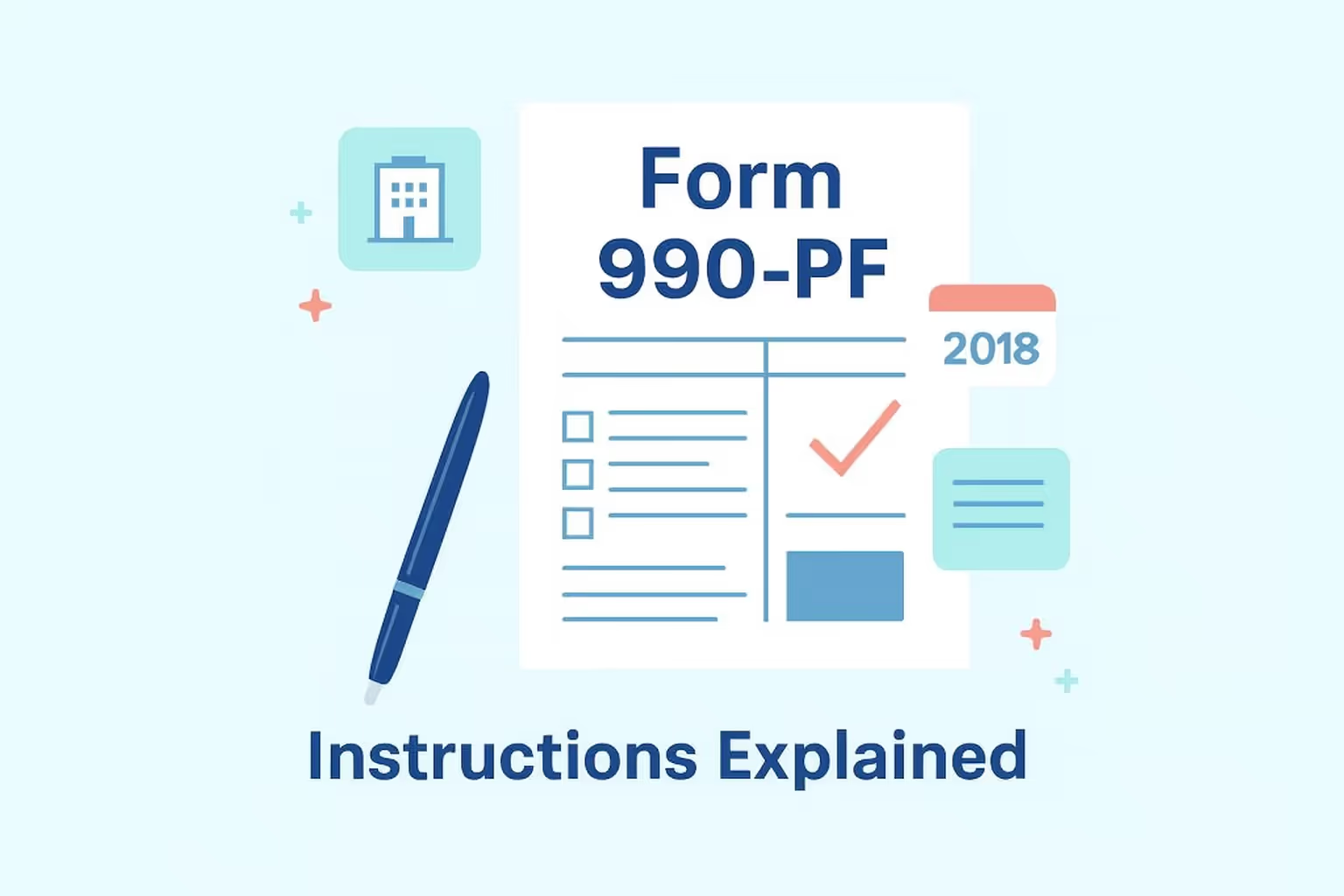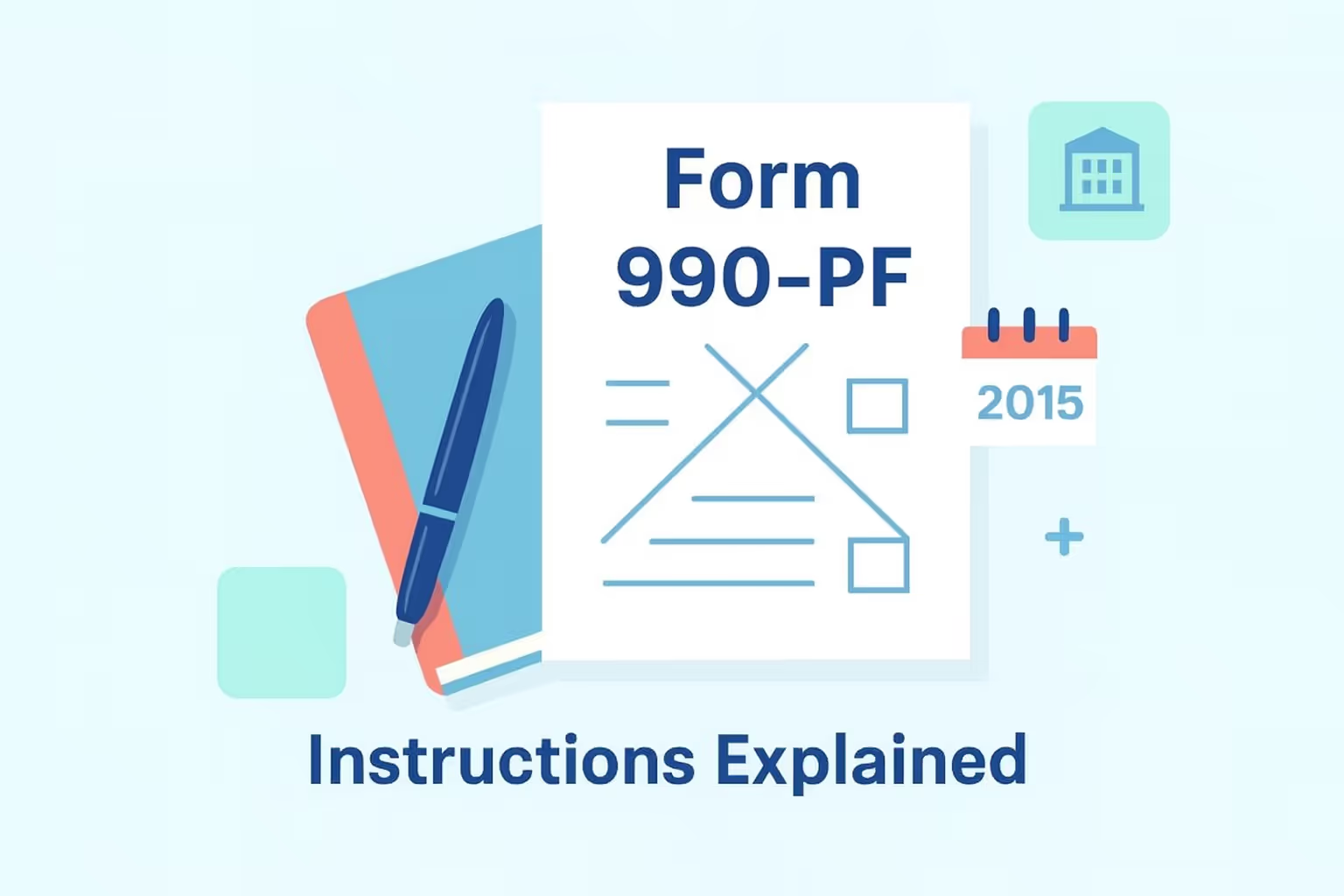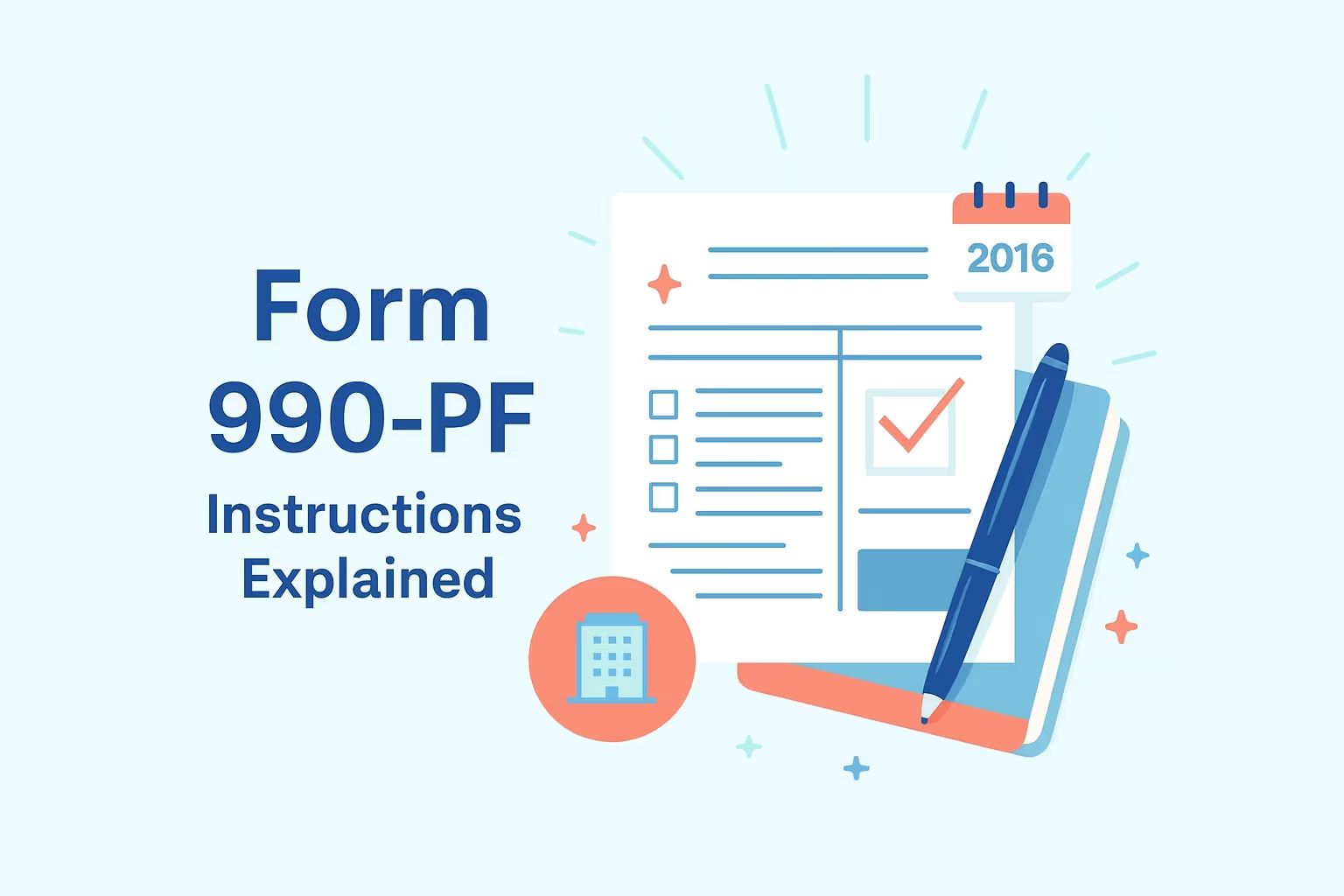Filing the return of a private foundation is a legal requirement that applies to every tax-exempt organization classified under section 501(c)(3). Unlike a public charity, a private foundation must report revenue, charitable distributions, and investment income in detail to maintain exempt status. Directors and staff may feel uncertain about the process; understanding the essentials ensures compliance with federal law and supports the mission. According to the IRS Form 990-PF overview, this filing functions as both a financial statement and a public disclosure document.
The Form 990-PF provides the IRS and the public with essential details about a foundation’s contributions, directors, and governance. It requires reporting of gross investment income, grants awarded to charitable programs, and how resources were used to advance the foundation’s exempt purpose. Although technical, this return is crucial for maintaining transparency and accountability, ensuring the foundation retains its tax-exempt status. Individuals preparing the form must also review names, identification numbers, and board documents for accuracy before submission.
For tax year 2022, private foundations must follow updated filing rules that include stricter standards on compensation reporting, net asset classification, and mandatory electronic filing. These changes impact how exempt organizations document their activities and demonstrate compliance. By focusing on preparation and accurate documentation, directors and officers can protect their exempt status and continue to support charitable programs effectively.
Return of Private Foundation
Filing Form 990-PF is more than a routine administrative step. It establishes how exempt organizations disclose their financial activities, maintain their tax-exempt status, and demonstrate accountability to the IRS, donors, and the public. By understanding the definition, purpose, and scope of this filing, foundation directors and officers can manage compliance more effectively while reinforcing trust in their organization.
Definition
The return of a private foundation, submitted through Form 990-PF, records the financial operations and governance of exempt organizations that qualify as private foundations. Unlike a public charity, which relies on a broad base of support, a private foundation typically receives contributions from individuals, families, or corporations. Because private foundations rely on fewer donors, they are required to provide detailed disclosures to demonstrate compliance with regulations.
Purpose
The return addresses several compliance goals. It documents gross investment income, calculates the excise tax on that income, and verifies that charitable distributions meet the minimum requirements for tax-exempt status. The filing also lists the employer identification number, the legal name, and the names of the board of directors. These disclosures enable regulators and the public to verify that the foundation continues to fulfill its obligations under Section 501(c)(3) of the Internal Revenue Code.
Scope of Filing
Entities required to file include section 501(c)(3) private foundations, charitable trusts under Section 4947(a)(1), and organizations that transitioned from public charity to private foundation status. Operating foundations must also file, but they provide additional information demonstrating that their programs and support activities qualify for their designation. Each category ensures that exempt organizations remain within the federal framework for compliance.
Importance
Comprehensive reporting strengthens confidence in a foundation’s operations. Donors, directors, and communities benefit from accurate records of contributions, board oversight, and charitable distributions. Transparent reporting affirms the foundation’s exempt status while confirming its dedication to serving the public. Treating the return as both a compliance requirement and a reaffirmation of mission helps foundations maintain credibility and stability.
Tax-Exempt Filing Requirements for Private Foundations
Meeting tax-exempt filing requirements ensures that private foundations remain in good standing as exempt organizations. Filing Form 990-PF confirms that the foundation complies with section 501(c)(3) rules and continues to qualify for federal recognition. Transparent reporting provides donors, directors, and the public with confidence that resources are managed responsibly.
- Who Must File: Private foundations under section 501(c)(3), charitable trusts under Section 4947(a)(1), and organizations that transitioned from public charity to private foundation status must file annually. Every foundation, regardless of its size or activity level, is required to submit a return to preserve its exempt status.
- Filing Scope and Deadlines: The return must disclose gross investment income, contributions, charitable distributions, and details of directors and officers. Documentation includes governance practices and legal identification numbers. The filing deadline typically falls on the fifteenth day of the fifth month following the end of the fiscal year, with many organizations submitting their returns in May. Extensions may be granted, but payment deadlines remain in effect.
- Required Documentation: Foundations must prepare comprehensive financial records, including balance sheets, statements of support, and information on their charitable programs. Reporting the names of directors, donors, and legal identification numbers strengthens accountability and ensures accurate disclosure. Both operating and non-operating foundations follow the exact requirements to maintain compliance.
Fulfilling filing obligations preserves the legal recognition of a foundation’s exempt status. Accurate, transparent submissions reflect a commitment to lawful practices and safeguard the ability to make charitable distributions effectively. Compliance is confirmed each year, ensuring the foundation operates within the framework of federal law while continuing to provide support to the public.
2022 Updates to Form 990-PF
Private foundations filing the return of a private foundation for the tax year 2022 faced significant updates that influenced reporting requirements. These changes directly affect how exempt organizations disclose contributions, calculate excise tax on gross investment income, and document charitable distributions. Staying informed on these revisions helps directors and officers safeguard exempt status while meeting federal standards.
Excise Tax Rate Reduction
The excise tax on net investment income permanently decreased from 2% to 1.39%. This adjustment reduces costs for many organizations and alters how gross income and related calculations are presented on the return. Compliance requires accurate application of the new rate across all financial documents.
Mandatory Electronic Filing
Every exempt foundation is required to file electronically, eliminating paper filing as a routine option. The electronic process promotes accuracy, security, and consistency across submissions. Directors and staff must select an authorized provider to meet this requirement, as explained in the 2022 Form 990-PF instructions.
Net Asset Classifications
Balance sheet reporting standards now require organizations to separate net assets with and without donor restrictions. This adjustment aligns federal filings with current accounting practices, ensuring consistency with audited statements.
Compensation Reporting Standards
Foundations must apply updated reporting rules for officers, directors, and employees. Older alternative methods are no longer valid, and only the current standards are applicable. Compliance demands accurate documentation of all payments connected to foundation management.
These 2022 changes represent a shift toward uniformity, transparency, and tighter oversight of exempt organizations. By applying the new standards carefully, foundations demonstrate accountability and reinforce trust with both donors and the public.
Tax Exempt Status and Charitable Distributions
Private foundations that hold tax-exempt status are required to comply with specific rules regarding charitable distributions. These requirements ensure that exempt organizations operate in accordance with the intent of Section 501(c)(3) and continue to qualify for recognition. Foundations demonstrate accountability by disclosing their contributions, investment income, and the manner in which they support charitable programs through the return of a private foundation.
- Exempt Status: Federal recognition as a tax-exempt organization allows it to operate without paying federal income tax. Maintaining this status requires comprehensive reporting of contributions, gross income, and activities tied to the foundation’s mission. Loss of exempt recognition can have a severe impact on both donors and recipients of charitable support.
- Charitable Distributions: Foundations are required to make minimum qualifying distributions each year to maintain compliance. These distributions include grants, scholarships, and direct program expenses that benefit the public. If the foundation fails to meet the required minimum distributions, it may incur excise taxes and risk losing its exempt status.
- Donor Contributions: Accurate reporting of contributions from individuals, corporations, or related entities is required. Each return must disclose the value of gifts received, the connection of donors to the foundation, and whether contributions meet the standards of section 501(c)(3). This transparency reassures donors and strengthens public trust.
- Board Oversight: Directors and officers play a crucial role in approving distributions and ensuring compliance with relevant regulations. The return must list the names, positions, and responsibilities of board members to document governance accountability. Active governance ensures that charitable purposes remain at the center of the organization’s activities.
- Supporting Documentation: Foundations must keep detailed records of charitable distributions, including agreements, contracts, or resolutions adopted by the board. These documents protect the organization during IRS reviews and confirm that charitable distributions meet legal definitions. Proper recordkeeping also demonstrates the connection between donor support and public benefit.
By following these requirements, private foundations reinforce their exempt status and maintain credibility. Accurate reporting of charitable distributions ensures that resources are directed toward programs that benefit the public, while demonstrating ongoing compliance with federal law.
Preparing to File Form 990-PF
Private foundations safeguard their exempt status by beginning preparation well in advance of the filing deadline. Gathering documents early provides directors and officers with the time needed to review gross investment income, contributions, and charitable distributions. Establishing a straightforward process for organizing records also demonstrates that the foundation operates within the standards set for exempt organizations.
Key Records to Collect
Organized record-keeping forms the basis of an accurate return for a private foundation. Every section of Form 990-PF relies on verified data, from balance sheets to donor information. Preparing detailed records shows accountability and ensures that the foundation’s financial and charitable activities withstand review.
- Prior Year Return: The foundation should review the previous filing to highlight recurring concerns and set benchmarks for accuracy.
- Financial Statements: Balance sheets, income records, and asset valuations must be aligned with the foundation’s books.
- Grant and Contribution Records: Documentation must clearly display the donor's name, contribution amount, and the public benefit achieved.
- Payroll and Compensation Data: Compensation for directors, officers, and staff must accurately reflect actual payments and adhere to current reporting standards.
- Board Records: Minutes, resolutions, and governance decisions must confirm oversight and demonstrate leadership accountability.
- Supporting Documents: Agreements, contracts, and correspondence related to distributions must be retained to ensure proper verification.
Why Preparation Matters
Adequate preparation ensures that the return meets all requirements under Section 501(c)(3). Organizing records in advance protects against errors and reinforces confidence in the foundation’s ability to manage exempt responsibilities. Accurate preparation also strengthens donor trust, confirms public accountability, and allows the foundation to focus on fulfilling its charitable purpose without disruption.
Step-by-Step Filing Walkthrough
Completing the return of a private foundation requires a straightforward process to ensure accuracy and compliance. Form 990-PF requests detailed information on gross investment income, contributions, charitable distributions, and governance activities. A structured seven-step approach allows exempt organizations to remain compliant with section 501(c)(3) and demonstrate transparency to donors and the public.
Step 1: Collect All Required Records
The foundation should gather financial statements, grant documentation, payroll records, and board meeting minutes before beginning the return. These records serve as the evidence needed to confirm exempt status and demonstrate the connection between contributions and charitable distributions. Comprehensive preparation reduces the likelihood of filing errors.
Step 2: Report Revenue, Expenses, and Net Assets
The filer must complete Parts I and II, which cover revenue, operating expenses, and balance sheets. Distinguish between book amounts, net investment income, adjusted net income, and charitable disbursements. Provide beginning- and end-of-year asset values and classify them as either with or without donor restrictions.
Step 3: Record Capital Gains, Losses, and Changes in Net Assets
Disclose all capital gains and losses in Part IV. Then complete Part III to document changes in net assets during the year. These figures show whether the foundation managed its resources in line with its exempt purpose.
Step 4: Provide Governance and Compensation Information
The filer must list the legal name, address, and employer identification number in the heading section. In Part VII, report on directors, officers, and key employees, along with their compensation details. Transparent disclosure of governance ensures accountability and compliance with federal requirements.
Step 5: Document Charitable Activities and Distributions
The filer should use Parts VI-A and VIII–X to describe charitable activities, program-related investments, and grants. Provide details that demonstrate public benefit and confirm that distributions meet minimum requirements. Supporting documentation must connect distributions directly to the foundation’s charitable purpose.
Step 6: Calculate Excise Tax and Distribution Requirements
In Part V, the filer must apply the 1.39% excise tax rate to net investment income, taking into account credits and estimated payments. Then, Parts XI and XII are used to calculate distributable amounts and verify that prior obligations have been met. These calculations ensure compliance with minimum distribution requirements.
Step 7: Complete Schedules, Attachments, and Submit Electronically
The filer must attach required schedules such as Schedule B and Part XV. The filer should add forms such as Form 4720 or Form 990-T, if applicable. The filer must review the return for consistency, submit it electronically, and keep records for at least three years.
Following these seven steps simplifies a complex process while protecting exempt status and reinforcing transparency. A consistent filing approach confirms compliance, builds public trust, and allows the foundation to focus on charitable goals without disruption.
Public Charity vs. Private Foundation
Organizations often wonder whether they qualify as a public charity or a private foundation. Both categories operate under Section 501(c)(3) and maintain tax-exempt status. Still, they differ in how they receive support, the requirements for charitable distributions, and the level of public accountability involved. Understanding these distinctions helps directors, donors, and exempt organizations maintain compliance and select the appropriate classification for their long-term operations.
Comparison of Public Charity and Private Foundation
Primary Support
- Public Charity: Receives a broad base of public support, including contributions from individuals, corporations, and government grants.
- Private Foundation: Relies on limited contributions from individuals, families, or corporations, often tied to a single source of funding.
Charitable Distributions
- Public Charity: Directly provides services and programs that serve the public.
- Private Foundation: Must make annual qualifying distributions, often in the form of grants to other organizations or individuals.
Governance
- Public Charity: Overseen by a diverse board of directors representing community interests.
- Private Foundation: Typically governed by a smaller board, often composed of family members or donors connected to the foundation.
Public Accountability
- Public Charity: Subject to broad public reporting and scrutiny due to reliance on community contributions.
- Private Foundation: Required to file detailed annual reports of gross income, charitable distributions, and governance, ensuring transparency through Form 990-PF.
Donor Deductibility
- Public Charity: Donors generally receive higher limits on tax deductions for their contributions.
- Private Foundation: Donor deductions may be limited depending on the type of contribution and the donor’s adjusted gross income.
Operational Focus
- Public Charity: Frequently provides direct services such as education, healthcare, or community support.
- Private Foundation: Typically funds external programs or provides grants while maintaining investment income to support long-term giving.
This comparison highlights the differences between private foundations and public charities in terms of structure and compliance obligations. Each category requires careful reporting of contributions, distributions, and board oversight to maintain tax-exempt recognition. Directors and officers should assess their organization’s funding sources and activities to determine which category applies.
By understanding the differences between public charities and private foundations, exempt organizations can align their operations with federal requirements. Transparent reporting of contributions, governance, and charitable distributions ensures continued compliance and strengthens public trust.
Filing Methods and Submission
Private foundations must use approved filing methods to submit their tax returns. Electronic submission is now mandatory for all exempt organizations, and paper filing is permitted only in rare cases, with prior approval from the IRS. Choosing the correct method ensures that gross investment income, contributions, and charitable distributions are reported securely and efficiently.
Electronic Filing
- Mandatory Requirement: All private foundations must submit Form 990-PF electronically, regardless of asset size or activity level.
- Authorized Providers: Filing must be processed through the systems listed on the IRS e-file for charities and nonprofits, which provide platforms for exempt organizations.
- Confirmation of Receipt: Electronic filing provides immediate confirmation that the return has been transmitted successfully.
- Attachments: Required schedules, such as Schedule B and Part XV, must be uploaded in electronic format as part of the submission.
- Security: Electronic filing ensures that sensitive information, such as employer identification numbers and board data, is protected.
Paper Filing (Rare Exception)
- Prior Approval Required: Paper filing is only permitted if the IRS grants a waiver, which is rare.
- Mailing Requirements: If approved, the foundation must mail the return to the designated IRS address using certified mail.
- Supporting Documentation: All attachments and schedules must accompany the return in paper form.
- Payment Handling: Any excise tax due must be paid separately using an approved payment method.
Payment of Tax Due
- Electronic Federal Tax Payment System: Foundations can make excise tax payments through EFTPS for accuracy and convenience.
- Direct Debit: Payment may also be scheduled as an electronic withdrawal during the filing process.
- Credit or Debit Card Options: Payments can be processed through IRS-approved card providers, though service fees may apply.
Following approved filing methods reinforces exempt status and demonstrates accountability. Secure systems ensure accurate reporting of contributions, distributions, and governance while protecting the organization’s compliance record.
Frequently Asked Questions
Do private foundations need to file Form 990-PF every year?
Yes. Every private foundation is required to file an annual return, regardless of its contributions or activities. Reporting gross investment income, charitable distributions, and board oversight ensures compliance with section 501(c)(3). Filing also protects exempt status by demonstrating transparency to donors, directors, and the public—failure to file for three consecutive years results in automatic loss of tax-exempt status.
How does a private foundation maintain tax-exempt status?
A private foundation maintains tax-exempt status by accurately documenting contributions, gross income, and charitable distributions. The organization must operate exclusively for exempt purposes defined under section 501(c)(3). Maintaining complete records, reporting board decisions, and ensuring distributions support the public all confirm compliance. Filing Form 990-PF each year safeguards the foundation’s recognition as an exempt organization and reinforces its accountability to donors and the communities it serves.
What counts as a qualifying charitable distribution?
Charitable distributions include grants, scholarships, and program-related investments that support exempt purposes. Private foundations must make minimum annual distributions to maintain compliance with section 501(c)(3). These distributions demonstrate that contributions are directed toward public benefit rather than private gain. Properly recorded distributions confirm that the organization supports its mission, complies with IRS requirements, and maintains the exempt status necessary to continue receiving tax-exempt recognition.
Can a private foundation transition into a public charity?
Yes. A foundation may reclassify as a public charity if it meets support tests demonstrating that contributions come from a broad donor base. Until approval, it must continue filing the return of a private foundation. If approved for public charity status, the organization must comply with specific reporting requirements while demonstrating that its distributions, governance, and management of gross income align with the tax-exempt purposes outlined in Section 501(c)(3) of the Internal Revenue Code.
What happens if a foundation fails to file?
Failure to file Form 990-PF can result in the loss of tax-exempt status and potential excise tax liabilities. Exempt organizations that fail to submit a return for three consecutive years automatically lose their recognition. Without exempt status, contributions may not be tax-deductible for donors, and the foundation may face additional excise taxes. Regularly meeting filing deadlines ensures continued recognition and confirms that directors, officers, and donors remain in compliance with federal standards.
How should donor contributions be reported?
All contributions must be recorded, including donor names, amounts, and their connections to the foundation. Schedule B requires disclosure of significant donor contributions, though this information is not released publicly. Proper documentation demonstrates compliance with section 501(c)(3) requirements and reinforces exempt status. Transparent reporting shows how contributions support charitable distributions and helps maintain accountability with both the IRS and the public.
How long should a private foundation keep records?
Private foundations must keep financial statements, contribution records, and board minutes for at least three years after filing. Certain documents, such as governing policies, donor agreements, and incorporation papers, should be retained permanently. Maintaining detailed records ensures readiness for an IRS audit, protects the foundation’s exempt status, and provides donors with confidence that their contributions directly support charitable distributions and exempt purposes under section 501(c)(3).





























